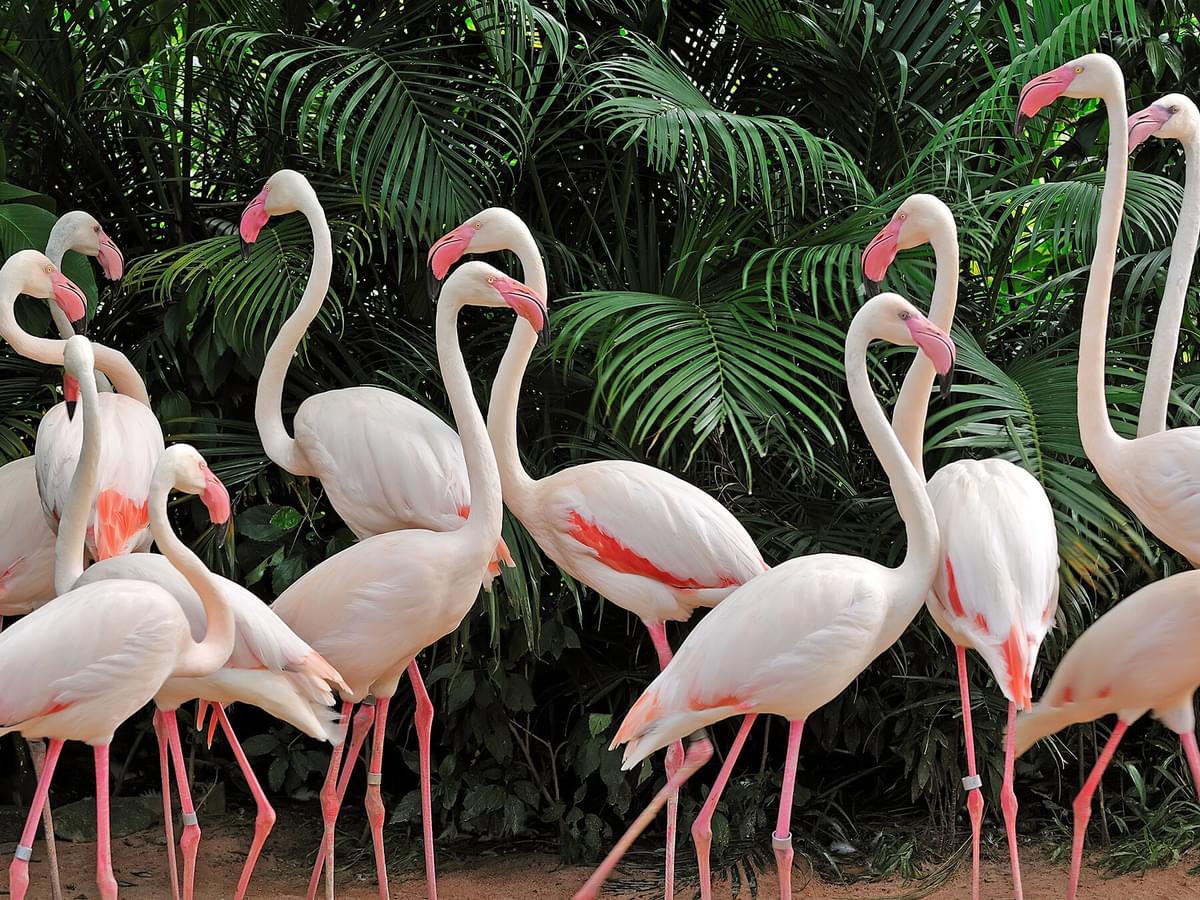Jump to Section
What is a Group of Flamingos Called? (Complete Guide)
Last updated: 19 January 2022

Flamingos are an iconic breed of bird, recognised by most people the world over, but actually seen in the flesh by far fewer, due to the locations of their habitats. There are in fact six species of flamingo, all of which are extremely gregarious and social birds, often gathering closely together in vast numbers. There are a number of self explanatory collective nouns frequently used to identify groups of flamingos.
Probably the most common and descriptive collective nouns for a group of flamingos are a ‘flamboyance’, ‘colony’ or ‘stand’, with flamboyance tending to be the most popular. Originating from the adjective flamboyant, an old French word originally meaning flame, it is frequently used in English to mean, stylish, colourful, bright, dazzling and flashy; words that epitomise our view of the magnificent flamingo. Interestingly the word flamingo comes from the Latin word ‘flamma’ which also means flame or fire.
The collective noun ‘colony of flamingos’ is often used to describe a group of flamingos as the chosen habitats of these birds are frequently rejected by other species and animals as being hostile environments due to extremely high concentrations of salt. The flamingos therefore move in to the region and colonise the area for themselves thus, by definition, forming a colony.
A ‘stand of flamingos’ almost certainly originated from observing their habit of standing motionless and resting for long periods, often on one leg, an extraordinary sight when viewed in large groups.

A flamboyance of flamingos
Other names for a flock of flamingos
Another easy to explain collective noun is a ‘regiment of flamingos’ which comes from their propensity to gather together and march in time in a manner similar to a group of well drilled soldiers.
The Lesser Flamingo, a native of Africa, is such a sociable bird that groups of up to a million individuals have been recorded nesting together and is the largest recorded flock of birds known to man. One can just imagine the chaos and excitement when large numbers of these birds take to the air by running across the surface of a lake and flapping their wings to lift off. This spectacle was possibly what gave rise to a further group name of ‘a flurry of flamingos’.
‘A skein of flamingos’, whilst not a common collective noun, is occasionally used, particularly with birds in flight. More usually the simple term of ‘flock’ which is applicable to the majority of bird species is used to categorise flamingos in flight.
There are reports of the collective noun ‘a veton of flamingos’ although the origin of this word is complex but appears to come from the Albanian language meaning lightning and is generally considered to be a boys name, albeit an uncommon one.

A standing of flamingos
What is a group of baby flamingos called?
Dependent upon age, young flamingos are generally known as chicks, hatchlings, juveniles or ‘a creche of flamingos’. This latter term refers to the rearing of a single chick by parents who then pass the chick on into a group which is guarded and supervised by a small number of adult flamingos during the day, but which return to their parents at night and at feeding times, in a similar fashion to human infants attending a creche or kindergarten.
Want to learn more about baby flamingos, check out this complete guide to them!
Why do flamingos group together in such large numbers?
The saying, ’having strength in numbers’ is highly applicable to flamingos who are able to achieve maximum success in raising young within large colonies. Breeding females lay just one egg per year and within each individual colony, all eggs are laid at the same time so that they hatch and the young grow up together.

A large flock of flamingos in Lake Nakuru, Kenya, Africa
Some interesting flamingo facts
Easily identified by their long necks and legs, they are also known for their characteristic white, crimson and pink plumage which is a result of the pigments found within their food, largely consisting of plankton, tiny aquatic invertebrates and algae. Generally, the primary and secondary flight feathers of all species of flamingo are black and contrast beautifully with the rest of the plumage when the birds are airborne.
Flamingos all have large downward curving bills, tipped black and a system of filtering food which they gather from just below the surface of stagnant or saline water and mud by turning their heads upside down and filtering the water through a system of combs within the bill using their extremely strong tongue as a ramrod.
Adult flamingos feed their young with a bright pink milky solution which is produced in their crop, otherwise known as the throat.
Three of the six species of flamingo, the Chilean, Andean and James’s Flamingo are native to the Andes and the southwest of South America.

A colony of Caribbean flamingos
The American Flamingo is found in the Caribbean, the Galapagos Islands and along the north coast of South America. This species has the deepest pink coloured plumage of all flamingos.
The Lesser and Greater Flamingos are located predominantly within South Africa and east Africa. Additionally, the Lesser Flamingo is also found in small numbers along West Africa’s coastline, specifically Senegal, Gambia and Guinea. Some Greater Flamingos also migrate to India and parts of the Middle East. Flamingos can be found in limited numbers along the coasts of southern Europe and Turkey as well.








